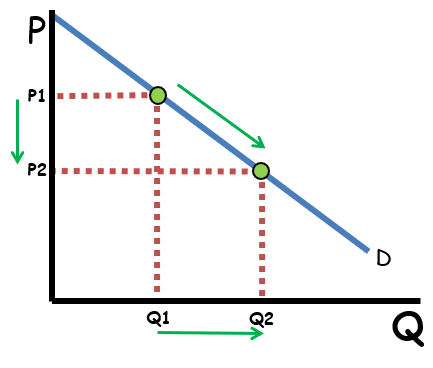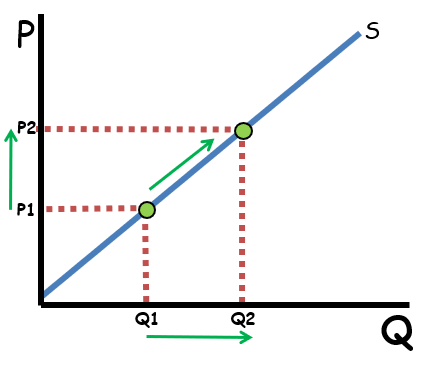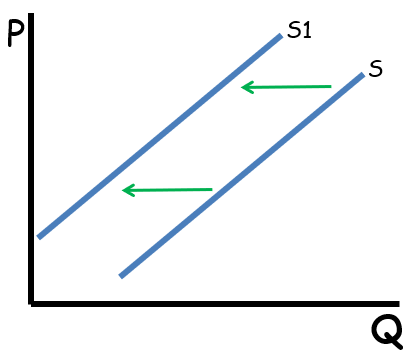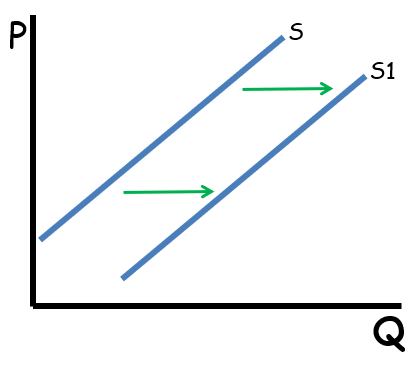4 questions about Supply and Demand answered
Updated 3/22/2024 Jacob Reed
1. What is demand?
The law of demand tells us that ceteris paribus (other things being equal), an increase in a good’s price causes a decrease in quantity demanded and a decrease in price causes an increase in quantity demanded. This change in price causes movement along the demand curve. It is important to note a change in price does not change demand. It only changes quantity demanded.

There are things besides price that cause a change in demand (a change in quantity demanded at every price). Those changes shift the entire curve (increases to the right and decreases to the left) giving us a change in demand. Those changes are called non-price determinants of demand.
2. What are the demand shifters?
There are 5 non-price determinants of demand; or demand shifters. Rightward shifts are always an increase, and leftward shifts are always a decrease.
- Consumer tastes and preferences: when goods go in then out of style the demand for those goods increase then decrease. Anything that would cause consumers to like a product more will shift demand to the right and anything that would cause consumers to like a product less will shift demand to the left.
- Market size (number of consumers): when the number of consumers available to purchase a product changes, the demand curve also shifts. More potential customers shifts demand right and fewer potential customers shifts demand to the left.
- Prices of related goods: Changes in the prices of substitutes have a direct relationship with changes in demand (when the price of a substitute increases, demand for the good in question also increases) and price changes for complements have an inverse relationship with demand changes (an increase in the price of a complement causes a decrease in the demand for the good in question)
If ice cream and frozen yogurt are substitutes then an increase in the price of ice cream will shift the demand for frozen yogurt to the right. If ice cream and hot fudge are complements, an increase in the price of ice cream will shift the demand for hot fudge to the left.
- Changes in income: when consumers’ incomes rise, they demand more normal goods and fewer inferior goods.
If Nike shoes are normal goods, an increase in consumers’ incomes will cause the demand of Nikes to increase. But if store brand cereal (the kind that comes in a bag) is an inferior good, that same increase in consumers’s incomes will cause a decrease in the demand for store brand cereal.
- Expectations of the future: predictions about the future impact the demand for a product today (an expected price increase a month from now will cause an increase in demand today).


*Note: The distinction between a change in demand (a new shifted curve) vs a change in quantity demanded (movement along the curve due to a price change) is key to fully understanding supply and demand. Price only changes quantity!
3. Why are demand curves downward sloping?
One reason why demand curves are downward sloping is the income effect. The income effect means that changes in price cause changes in income purchasing power. If a consumer has $10 worth of income and candy bars cost $1 each, that consumer’s income has the purchasing power of 10 candy bars. If the price of candy bars rises to $2 each, the purchasing power of the $10 will only be 5 candy bars. If the price of candy bars falls to 50 cents, $10 has a purchasing power of 20 candy bars. In other words, when prices fall, consumers can afford more and when prices rise, consumers can’t afford as many.
The substitution effect is another reason why demand curves are downward sloping. This effect says that when the price of a good or service rises, consumers will substitute that good for less expensive alternatives. Conversely, when the price of a good falls, consumers will purchase more of the good in question and fewer of the alternatives. For example, if the price of frozen yogurt rises, consumers will purchase less frozen yogurt because they will buy ice cream instead.
The third reason why demand curves are downward sloping is Diminishing Marginal Utility. This is a microeconomic concept that tells us the benefit (utility) gained by consuming more of a good or service decreases with each unit consumed. So if Jenny eats 1 cheeseburger, she might gain 100 utils (units of satisfaction or benefit), eating a second cheeseburger might be worth 50 utils to her, a third worth 10, and a fourth worth 1 util. While her total utility increases with each cheeseburger consumed (100, 150, 160, then 161), the marginal utility (additional benefit) decreases with each cheeseburger consumed. As a result when prices rise, the fewer units are worth buying for consumers.
4. What is Supply?
The law of supply says that Ceteris Paribus, an increase in a good’s price causes an increase in quantity supplied and a decrease in a good’s price causes a decrease in quantity supplied. Just like demand, a change in price only causes movement along the supply curve. A change in price will not change supply; only quantity supplied.

When something other than price changes, it can cause the entire supply curve to shift (a change in supply as it’s called) to the right (increase) or to the left (decrease). Those changes are called non-price determinants of supply.
5. What are the supply shifters?
When it comes to supply, there are 6 non-price determinants; or supply shifters. Rightward shifts are always an increase, and leftward shifts are always a decrease.
- Prices of resources or inputs: increases in resource prices decrease supply and decreases in resource prices increase supply.
If wages for bakers increases, then the supply of cakes will decrease. Or, if the price of sugar decreases, the supply of candy will increase.
Government tools: actions of the government impact supply. Taxes decrease supply, subsidies increase supply, and regulations generally decrease supply.
Competition (or number of sellers): when businesses selling the same product enter the market, the supply of the product shifts to the right. When businesses exit the market, the supply of the product shifts to the left.
Technology: better technology shifts the supply curve to the right.
Prices of other goods: can cause a change in the allocation of resources, shifting the supply of the product in question. If the price of corn increases, the supply of wheat will decrease as farmers shift resources over to the production of corn.
Producer Expectations: Producer expectations about future prices, etc can impact production today. When businesses expect to get a high price, for example, they may produced more today (without any guarantee of that high price).
*Note: The distinction between a change in supply (a new shifted curve) vs a change in quantity supplied (movement along the curve due to a price change) is key to fully understanding supply and demand. Price only changes quantity!


*Note: Different books and teachers may have more or different determinants than I have listed above. This list of determinants is not exhaustive, but it covers the primary determinants you are most likely to seen on your exams. The key here is to think like a consumer or producer and logically figure out how that would impact supply or demand.
Ready to learn what happens when supply and demand interact? Read about it in the Market Equilibrium review.
Multiple Choice Connections:
2012 Released AP Microeconomics Exam Question: 20
Up Next:
Review Game: Determinants of Supply and Demand Sorting Activity
Content Review Page: Market Equilibrium
Other recommended resource: ACDC Video
